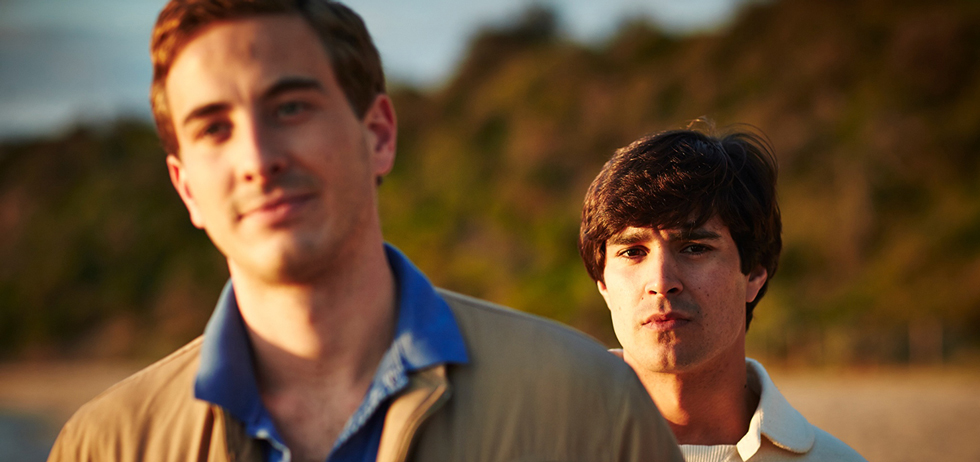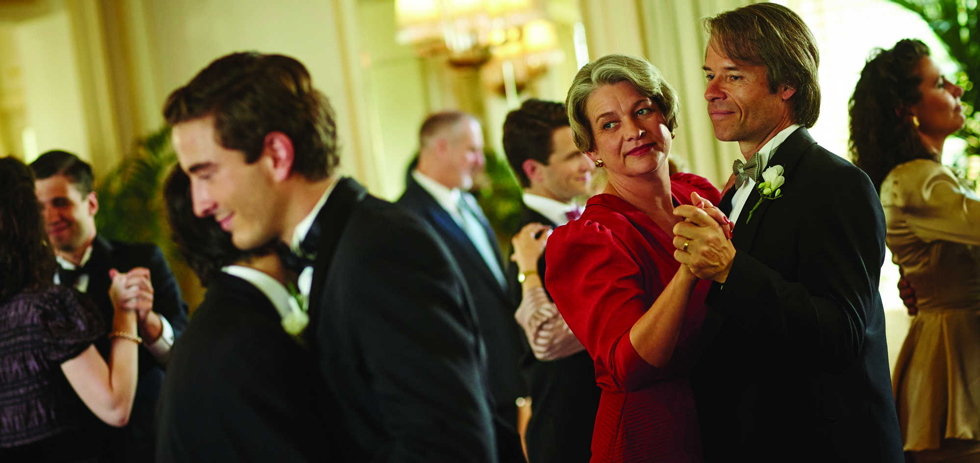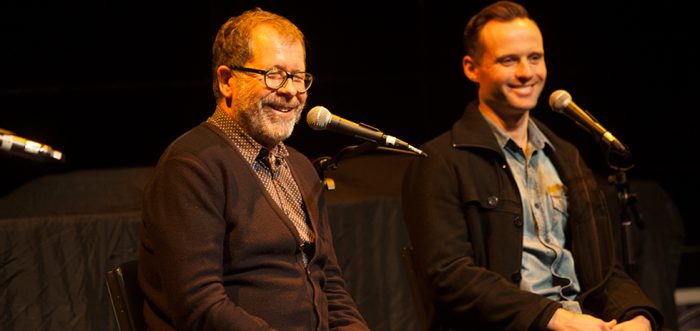Now out in cinemas, Neil Armfield and Tommy Murphy’s filmic adaptation of Timothy Conigrave’s iconic memoir Holding The Man has received its fair share of rave reviews locally, ours among them. The film is a heartbreaking chronicle of a romance; following the story of Tim and his partner John through sexual exploration and through a joint AIDS diagnosis at the height of the epidemic in the 1980s. Melba Proestos spoke to Armfield and Murphy about their film in time for its theatrical release.
Neil Armfield: Did you go to the press screening this morning?
Actually, I saw it at Sydney Film Festival on closing night
NA: Oh, great.
Tommy Murphy: Right. It was a good night to see it!
NA: The State Theatre – what a setting!
It really topped off a strong Festival. The film – along with your speech, Neil – was so moving that by the time the credits rolled, there wasn’t a dry eye in the house.
TM: Absolutely!
NA: Aw, thanks. The thing I liked best was calling out ‘stop the film!’ (Laughs) And the more I think about it, the more I think that what happened was a ghostly occurrence, because they had no idea how that could have happened technically, that two of the colours could have cut out of the projector.1 Tim was a member of the Pink Theatre Company, you know.
TM: Also, Tim had a connection with the projectionist in the book. You know, he worked as an usher in that cinema in Melbourne, and then goes up to the projectionist…
NA: Oh yeah, as he gets off with the projectionist, or goes home to his house and…
TM: Yeah, yeah.
NA: But, not that projectionist at the State.
TM: No, not that projectionist.
NA: But a projectionist. He knew his way around a projectionist’s room…
TM: That’s true, yeah. (Laughs)
Speaking of the Festival, it certainly revealed itself to be the year of adaptations for Australian cinema. From Last Cab to Darwin, The Daughter and Ruben Guthrie, which went from stage to screen, to The Secret River and your film Holding the Man, which went from the page to the stage to the screen.
NA: Yeah, interesting that, isn’t it?
So, Tommy, when you began work on the screenplay, did you approach it as a fresh adaptation of the book, or did you revisit the script you’d written for the play?
TM: Absolutely, we went back to the book. There might be some solutions that were found in the play, lessons in how to dramatize those characters, or there might be tiny bits of dialogue that come straight from the play, but at the end of the day, this is an adaptation of Tim’s book, because it would be such a mistake to try to, you know, film a play, try to create a piece of cinema that is a play. It’s so clear that the joys of making a play and what it does to its audience is such a different thing to what you do in a film. So, yeah, this is an adaptation of Tim’s book.
It’s clear that staying true to the original text was a priority for you and while – for me, anyway – the mere mention of adaptations usually conjures an image of Nicholas Cage banging away at the typewriter, struggling to write a screenplay of ‘The Orchid Thief’ in Spike Jonze’s Adaptation. I get the feeling that your experience on this occasion couldn’t be more different. His problem there was an inability to find a hook, an angle, because of an obvious lack of connection to the source text.
TM: Yeah, and this was never a struggle, because it was always just about so many choices. There are so many possible ways to represent Tim Conigrave’s vivid recollection of his life. There are so many pictures and so many sequences that we could have taken inspiration from.

This is a book that’s been reprinted 13 times, it stands to reason that thousands of people the world over have a personal connection to the story and I imagine you do too. What makes this story so special and so worthy of revisiting?
NA: There’s so much that’s special about it, but I think the fact that it exists because Tim willed it into existence, you know? If he lived a life like the rest of us live, he would have had that experience and died and been forgotten, really, because there was such an effort to smooth over the history of what their relationship had been. But he was led by some kind of desire to express himself which took shape by going to NIDA and that wasn’t entirely satisfactory for him, and then he formed the group of NIDA kids to respond to the world surrounding him, which was the AIDS crisis. Then, with this hideous irony, he discovered that he was HIV positive within it as part of that process, but the play went on and he went on to write other plays as well. And then after John died and as Tim’s mind was going he harnessed the energy to gather his notes together and to write this memoir and that’s what’s so special, that he caused this film to happen.
TM: I think my favourite thing is also that privileged view that he gives you of every aspect of his life and his love affair, and it includes such rich detail of his world and of himself and exposes very honestly his failing as well as his triumphs and passions. I love that the film makes good use of that. The film gives you this very privileged, close view of these private tender and very human moments.
Successfully presenting those tender, human moments could have only been achieved with clever writing, inspired direction, and really great chemistry between the leads. How challenging was the casting process?
NA: It was daunting; casting is always daunting, or doing anything, really! But once you get into the rhythm of casting, the pleasure of it is you learn so much about the thing it is that you’re creating.
TM: Yeah, that’s true!
NA: You sure do. And if you remember the end of the film, after the credits there’s that little sort of ’70s snapshot that comes up of Tim and John in a caravan park… that picture – we don’t know who took it – just sort of surfaced on Facebook and then it was taken down. Then it got grabbed when it was on Facebook and it was used by a production of the play as a program image in LA and I went and saw that and grabbed the picture and it became my sort of little talisman for what we had to find. The Tim we were looking for didn’t have to look like that, but carry that sort of sense of the way he looks at the camera, that he’s fronting the couple and John is so beautiful and gentle beside him, but determined and so tucked in there. And so it really helped me to just get what the balance between the two boys was – both so very different — because it became the roles that everyone of a generation was going for and we saw some three or four hundred tests and everyone saw themselves either as a Tim or a John. Some people saw themselves as both. (Laughs) And you can’t have one without the other.
I had a coffee with one of Tim’s friends, Karl Steinberg – who is talked about in the book, went to AFTRS and is a filmmaker himself – before we started pre-production and I said that we’d decided to go with the same actors. He said you can’t, you cannot have actors in their mid-twenties playing sixteen-year-olds because the most important thing about this story is that as sixteen-year-old school boys, they had the courage to begin this relationship that can’t be sort of faked. I said I thought these guys will carry themselves forward and back in a way that we’ll be able to identify and invest in. I suppose it was once we found Ryan Corr and Craig Stott together that we abandoned the change of cast even though the script had really been written around a change of cast.
TM: But it was always going to provide that opportunity if you needed it; there was that gap in time.
NA: Yeah, to what, have the change?
TM: Yeah, that you could. Yeah, yeah, but it was never really going to work, I never really thought. Cause you know –
NA: Tommy was more against the idea of changing it I think from the beginning.
TM: Or just in story terms, I thought you can’t easily get that big time gap that’s required and I think you connect emotionally, you know–
NA: — at the same time like, you know, I saw the Beach Boys film this year.
Love & Mercy?
NA: Yeah, and that played brilliantly with a change of actors. Xavier Dolan’s film Mommy has a sudden sort of flash forward where there’s a change of actor, a fantasy change, and I saw that film just before we started making Holding the Man and that was such a blast, really. But this is a very different film —
TM: — and the people that we looking at, it was never… it was never the same combination as of Ryan and Craig together.
NA: And also the Beach Boys thing made sense because it was focused on one person, but I think when it’s about a relationship, it’s much harder to travel a lot, and Shine was the same, it was about David Helfgott going through sort of, three or four different phases of his life. But not about two people doing that. And ultimately an audience will kind of accept whatever it is you are giving them if you give it to them confidently enough, and as long as they know what they are meant to believe. People love suspending disbelief, people love to do that. It’s a challenge and they do it generously if the story kind of gives them what they want along the way – as long as you’re clear about what you’re asking and that’s something I’ve learned over many years in theatre. And we definitely kind of felt ultimately that the last third of the film would be much more powerful if you’d followed the same actor all the way through and that was the case.

In amongst some of this country’s biggest names – Guy Pearce, Anthony LaPaglia and Sarah Snook, I was delighted to see some very talented theatre actors, like Mitchell Butel and Luke Mullins, make an appearance. It would appear that every single person that populated this world was handpicked because of the chemistry they demonstrated with their cohabitants. This is especially true of the two families, the Conigraves and the Caleos. Was this difficult to achieve?
NA: Yeah. Getting the personality of both families was very important, but kinda came quite late like Camilla was cast very late, Bob – Anthony LaPaglia – was cast very early. But getting the right balance with his wife was important. We’d been through a number of names and one of them was Kerry Fox, then suddenly it occurred to us that actually Kerry would be much better as Mary Gert, so she ended up over there. But yes, it’s terribly important to use the right mix of actors. Particularly with the Conigraves, and particularly with Lois and with Nick, you get to spend not very much time with them in the film, so you’ve got to be able to truthfully read how the family works very quickly.
TM: I am so pleased, given the more restricted screen time than the main characters, that there’s a really clear spine across the story of the parents. And it’s because of the strength of the performance that I think you really feel that story from the parents’ perspective and I imagine for some people that provides a way into the story as well, because Holding the Man is many things but, one of the things it is, is a story about how to parent, I think. As well as what a parent’s response is to the various crises that crop up.
It’s not something I remember taking notice of when I read the book about a decade ago, but it is something that struck me while watching the film.
NA: Yeah. I think that’s an area of absolute fascination for both Tommy and I – that relationship with family and how they shape us.
TM: Yeah, I mean when you’re making a selection of the source material it feels like there’s on emphasis that arrives and the themes of family and parenting did just that.
The film hits screens at a time when Australians are fighting a seemingly losing battle for marriage equality. Did you always set out to make such a politically charged film?
NA: I think we did set out to make a politically charged film, but we had no idea that the environment would be so ready to receive the charge.
There’s definitely an appetite for it, isn’t there?
NA: Yeah, yeah.
TM: We engaged Warren Entsch as our publicist and it’s a great choice!
NA: That’s a fabulous irony, really, that this is all going on in the week that it comes out.2
What sort of impact do you hope that the film will have on local audiences?
TM: I want them to photograph their sad faces on Instagram as they leave the cinema like in that film. What was that film?
NA: The Fault in Our Stars.
TM: I loved how that caught on, so a selfie of your crying ugly face, please!
NA: I think that for those who haven’t come to this realisation already, the proper human empathy for all people and all sexualities and just a really fundamental understanding of what’s fair and how important love is, whoever is feeling it. And that it is what makes people better, and that it’s what makes two lives stronger than one.
TM: That’s right isn’t it? Maybe the reason we do all of this is to make people love each other more. Maybe it might sound a bit Disney, but at the end of the day everything that goes into it and all that comes with it, bound with a lot of politics and whatever else, but that people love each other more.
Holding the Man is now out in cinemas.
